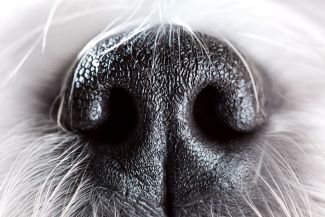My current answer is... maybe... in some situations... potentially.
Dog nose closeup

Photo courtesy of Depositphotos
I’ve written about COVID-19 scent-detection dogs before, and I’ve done a variety of interviews on the subject, but it keeps coming up.
Can scent-detection dogs help with COVID-19 control?
The answer is (as with many things about the SARS-CoV-2 virus) less than clear. My current answer is… maybe… in some situations… potentially.
Let’s break it down.
Can dogs detect SARS-CoV-2 using their sense of smell?
Presumably not. The virus should have no smell.
Can dogs detect SARS-CoV-2 infection using their sense of smell?
It appears that some dogs, in some situations, can actually do this. There are a few preliminary studies of varying strengths (from laughable to pretty good) indicating that dogs can detect infected people. They aren’t smelling the virus though, they’re smelling something that an infected person’s body produces in response to virus.
What are the the dogs detecting in infected people?
We don’t know exactly what the dogs are smelling, which makes it harder to train and assess them. If we had “eau de COVID-19″ it would make training and assessment much easier. As of yet, we don’t know the best sample for dog’s to smell (saliva vs nasopharyngeal swabs vs skin wipes vs sweat vs…?) or the best kind of patient (really sick person vs moderately sick person vs asymptomatic person…?) from which to get the samples for training.
Can a dog detect someone with COVID-19 walking by?
We don’t know. The best work has been done with samples taken directly from a person, such as sweat wipes. I haven’t seen any data about dogs detecting infected people from just sniffing around them (despite the Miami Heat trying to use dog walk-bys to screen fans for COVID-19).
Can dogs be used to tell if someone doesn’t have COVID-19, so they can be allowed to do something or go somewhere (e.g. use public transit, or attend an event like a basketball game)?
Maybe, but it depends on the scenario. At best, dogs are going to be a reasonably good screening tool for COVID-19. They won’t be 100% accurate, so we can’t rely on them in critical situations. But they could be an adjunct screening tool that’s far from perfect but still useful.
Where might scent-detection dogs be used to help with COVID-19 control?
I do NOT see scent detection dogs as a tool to say either:
- Yes, this person is infected. They need to go home.
- No, this person is good. Off they go.
If dogs are actually good at detecting people from a distance, then they could be used like rapid antigen tests to say either:
- Yes, you’re good to go. But still wear your mask and do everything else because I’m not perfect.
- Hang on a minute… something might be up. You need to go for a PCR test to find out for sure.
Even if dogs aren’t that good for rapid individual screening, they could still be useful. I think the greatest potential is identifying high risk environments. For example, they could be taken into a homeless shelter, workplace, migrant worker housing or other high risk environment, and if they detect a whiff of COVID-19, that would be the trigger to bring in targeted testing (rather than the dog trying to figure out which individual are positive).
Rapid, cheap, person-side antigen testing will probably be more useful than dog screening, but scent-detection dogs could be useful in some situations if rapid testing isn’t universally available.
First we need to know that COVID-19 scent-detection dogs work, how well they work, and their limitations. As with a lot of things, this is an area where some people have jumped from “idea” to “application,” without all the necessary steps in between.
What we can’t do is try to use these dogs as untested tools that give people false confidence to engage in higher risk behaviours (like having them at the door of a sporting event). They’re a potentially useful add-on, but not an excuse to do something that wouldn’t be done without them. So, if an event is going on and rules at set, sure, add dogs as an additional measure. If the dogs are being used as the argument to allow people in, allow more people in or allow them to reduce infection control measures, that’s possibly counterproductive.
Republished with permission from Worms and Germs Blog